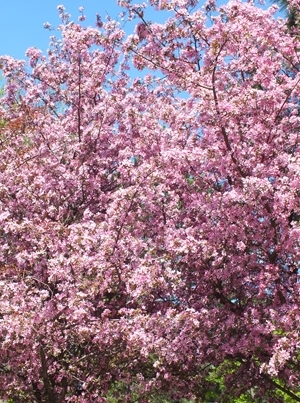The crab apple (Malus sylvestris)
 To me one of the finest sights of spring is when I come across a wild crab apple tree in full blossom. These relatively small native trees, which only ever reach a height of around 10 metres, are often found as single trees growing along old hedgerows or perhaps in a small copse.
To me one of the finest sights of spring is when I come across a wild crab apple tree in full blossom. These relatively small native trees, which only ever reach a height of around 10 metres, are often found as single trees growing along old hedgerows or perhaps in a small copse.
During April and early May, these little trees – that have perhaps remained unnoticed for much of the year – make up for their diminutive nature by putting on a display of exquisite beauty. In fact, they become conspicuous landscape features at this time of year and were the third most mentioned boundary feature in Anglo-Saxon charters, with around 10% of 658 charters examined making a note of them.
The smal,, tight flower buds are pale pink at first, turning to white as they open, which helps to show off the central golden stamens, while the tree itself can hardly be seen due to the density of blossom. If you should stand under the boughs of such a tree on a warm, still spring day, the hum of bees and other insects attending the sweetly-smelling, nectar-rich blooms can create an unbelievable din!
The true wild crab is a comparatively scarce tree that has quite spiny branches and forms a rounded, dense, almost impenetrable canopy. Some old trees can become quite gnarled and twisted, especially when growing in exposed positions and this 'crabbed' appearance may well have influenced the choice of name – crab apple.
Much more frequently encountered, however, are wildings – the collective name for chance seedlings, which although related to the crab, have grown up from discarded domestic apples.
The crab apple is the most significant ancestor of the cultivated apple, from which around 6,000 named varieties have been bred, although nowadays probably only a third of these survive. In the natural world, apples must cross-pollinate to produce fruit, so “cultivated” varieties are produced through human intervention to keep them true to their name. When a discarded apple core’s pip germinates, it can produce all manner of characteristics, often going way back into its history to imitate a distant, ancient ancestor. Wildings, therefore, harbour an extraordinary genetic reservoir.
The small yellow or green crab apple is only 2-3cm across and sometimes is flushed with red when ripe. The fruit is unbelievably sour but many species of bird and mammal eat the apples and help to disperse the seeds. Quite often, in mid-winter, you can come across a single crab apple tree that is “owned” by a cock pheasant or mistle thrush, which will chase other birds away in an attempt to keep all the fruits for themselves.
Although too sour for us to eat straight from the tree, the fruits can, of course, be turned into a delicious, orangey-pink crab apple jelly, which makes a wonderful accompaniment to roast pork. The fruit is also high in pectin, which helps with the setting process, so it is often added to other fruit when making jam to improve the consistency.
The crab apple has also played its part in British folklore. In the Middle Ages, the lord of the small market town of Egremont in Cumbria started a tradition of giving away crab apples collected from his land to the poor. So, way back in 1267 a “crab fair” was started and the tradition continues to this day with the parade of an apple cart, where apples are thrown to the crowds, which throng the main street.
Crab apples have long been associated with love and marriage, and it was said that if you throw the pips into the fire while saying the name of your love, the love is true if the pips explode!
So, you may not have realised it, but the humble little crab apple tree has played quite a prominent role in our lives for centuries past and who knows what its importance may be in the future. Just remember that when you next bite into a large juicy apple!
Peter Thompson
Advisory
Read more from Peter Thompson at the Fresh from the Field blog.